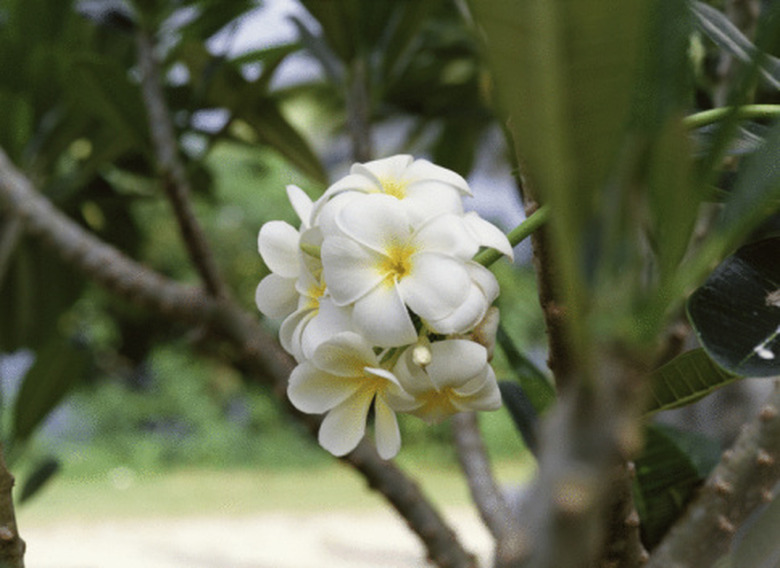What Is Plumeria's Growth Rate?
We may receive a commission on purchases made from links.
Commonly called frangipani, plumeria (Plumeria spp., U.S. Department of Agriculture plant hardiness zones 10 through 12) adds an exotic touch to landscapes. This is largely due to its deliciously scented flowers and enormous, tropical-looking leaves that may reach 16 inches in length. Plumeria's growth rate depends, in part, on the species of the plant.
Although red plumeria (Plumeria rubra) and white plumeria (Plumeria alba, also P. obtusa) both reach a potential mature height of 25 feet, each has a different annual growth rate. Other factors that influence plumeria's development include its cultural needs and environmental conditions, both of which can help or hinder healthy growth.
Plumeria Growth Rate by Species
Plumeria Growth Rate by Species
|
Plumeria Species |
Growth Rate |
|
Red plumeria |
12 – 24 inches per year |
|
White plumeria |
24– 36 inches per year |
Red plumeria bears 4-inch flowers in varying shades of pink or red, and white plumeria produces 3-inch blooms of white with bright yellow centers. Both trees may flower in spring, summer or fall, perfuming the air with the scent of their blossoms. Even gardeners who've never grown plumeria may recognize the plant's blooms as a staple in Hawaiian leis, which are garlands of flowers often worn around the neck. Because the growth rate of these two plumerias is species-specific, you may notice that your red plumeria grows taller than your white plumeria in the early stages.
Under optimal conditions, red plumeria grows 12 to 24 inches per year, and white plumeria grows 24 to 36 inches per year. When they're not in bloom during the growing season, you may be able to identify each species because of the length of the leaves. The deciduous leaves of red plumeria typically grow a little longer (to 16 inches) than those on white plumeria (12 inches).
Optimizing Plumeria's Growth Rate
Optimizing Plumeria's Growth Rate
Properly caring for plumeria has a positive impact on its growth rate. Environmental conditions also contribute to plumeria's healthy growth. Even though many environmental conditions, such as weather, are factors over which you have no control, there are some steps you can take to overcome or mitigate some of these adverse influences. You'll be able to tweak some environmental challenges more easily, however, before you plant a plumeria instead of trying to correct a defect after the tree is established.
You're likely growing plumeria to enjoy the beauty and fragrance of its flowers. But if you plant plumeria in a location that doesn't receive full sun, its growth rate will potentially be slower, and it may not reach its flowering potential. Well-draining soil is another must-have for plumeria, and plants may struggle to fend off fungal root rot diseases that favor wet or soggy sites. Although you cannot control rainfall, planting a plumeria on a raised berm or on soil that you amend with organic matter helps improve drainage after heavy rains.
Growing Plumeria in Containers
Growing Plumeria in Containers
Unless you live in a warm climate within USDA zones 10 through 12, you'll have to grow plumeria plants indoors in a container during cold weather and move it back outside with the onset of warm weather; otherwise, plumeria will not survive freezing temperatures outside. In fact, it will even drop its leaves and stop blooming when temperatures reach 50 degrees F.
Although a potted plumeria may never reach its full growth potential because of how a container restricts root growth, you'll still be able to enjoy it as a flowering deck or patio plant in summer. Choose a large container with a drainage hole, and fill it with a fast-draining coarse potting mix. Plant the plumeria in the container no deeper than it was growing in the nursery pot and gently tamp the potting mix around the roots. Fertilize plumeria with a fertilizer for flowering plants, applied according to label directions only during the growing season to promote lush foliage and plentiful flowers.
